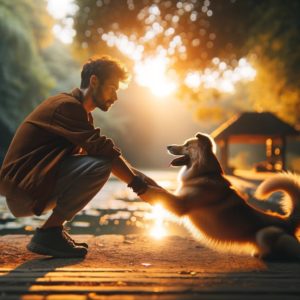As pet owners, we naturally wish to understand what our pets are feeling. We seek to decipher their emotions from the wag of a tail, the purr of contentment, or the anxious pacing in unfamiliar surroundings. While this endeavor springs from a place of love and care, it can also lead us into the territory of anthropomorphism, attributing human characteristics or behaviors to animals.
Chapter 1: Understanding the Pitfalls of Anthropomorphism: Reading Pet Emotions Correctly
Our relationships with pets often enrich our lives in countless ways. They offer companionship, unconditional love, and a unique bond that is truly irreplaceable. As we interact and bond with our pets, we naturally try to understand their emotions, and in doing so, we sometimes attribute human characteristics to them – a phenomenon known as anthropomorphism. While anthropomorphism can help us feel closer to our pets, it can also lead to misunderstandings and misconceptions about their behaviors.
The Misinterpretation of Pet Behaviors
One of the most common pitfalls of anthropomorphism is the misinterpretation of our pets’ behaviors. A quintessential example is the misunderstanding of a dog’s tail wagging. Most people associate tail wagging with happiness or excitement. However, depending on the context and the specific way the tail is wagging – fast or slow, high or low – it can also express agitation, fear, or aggression. Misinterpreting these signals can potentially lead to problematic interactions, such as approaching a scared or aggressive dog under the assumption that it is happy.
Similarly, cats purr for a variety of reasons. While purring is often associated with contentment, cats also purr when they’re anxious, or even when they’re injured or ill. Misinterpreting this signal could mean missing signs of stress or illness in our feline friends.
The Dangers of Imposing Human Emotions
When we anthropomorphize our pets, we often impose our human emotions and motivations onto them. This can lead to further misunderstandings. For example, many pet owners believe their pets can feel guilt, interpreting behaviors such as avoiding eye contact or slinking away as signs of remorse. However, research suggests that what we perceive as guilt is more likely fear or anxiety in response to the owner’s anger or disappointment.
If we assume that our pets feel guilt in the same way we do, we might punish them for behaviors that are natural to their species or that they don’t understand as wrong. This can create a stressful environment for the pet and strain the bond between pet and owner.
The Risk of Neglecting Pets’ Needs
Anthropomorphizing our pets can also risk neglecting their specific needs. Pets have different needs compared to humans, from their dietary requirements to their ways of socializing. For example, a dog might chew furniture or shoes out of boredom or lack of exercise, not out of spite or misbehavior. Misinterpreting such behaviors can lead to inappropriate responses, which do not address the underlying issue.
__
While anthropomorphism can help us feel a closer connection to our pets, it’s important to be aware of its potential pitfalls. Misinterpreting our pets’ behaviors and imposing our own emotions onto them can lead to misunderstandings, inappropriate responses, and potentially neglecting their needs. To truly understand and cater to our pets’ emotions, we need to balance our empathy with a thorough understanding of their species-specific behaviors. This way, we can ensure that our pets are not just loved, but also well-understood and properly cared for.







